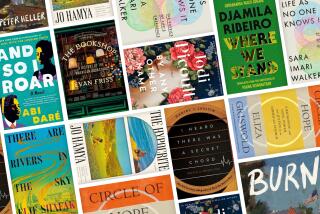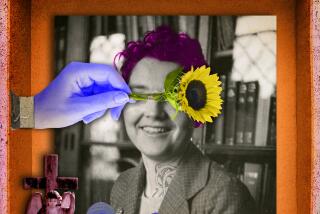Ocean Generates âWavesâ of Inspiration : Rocks, water and sand become symbolic on Jan Gregoryâs daily jogs. The Laguna Beach therapist has self-published essays inspired by those observations.
LAGUNA BEACH â Her daily jog along the shoreline provided both the setting and the inspiration for âThe Wave Watcher,â Laguna Beach psychotherapist Jan Gregoryâs self-published collection of inspirational essays.
Written in âmeditative reverie,â the book (PCS-Presents; $21.95) offers two dozen 500 to 1,200-word essays on life and living. Inspired by her âmentor, the peaceful ocean,â Gregory uses the waves, rocks and other natural elements she encounters on her jogs along the beach as metaphors in her observations about everything from living in harmony with nature to making positive choices in life.
âI didnât set out to do it; it sort of just happened,â Gregory says. âOn one run I saw all these little birds that were in my way, and as I sat down I would write about these experiences.â
In her essay titled âAn Orderly Whole,â the birds she encountered symbolize human relationships and the bonding that occurs: Watching a male bird protecting a flock of 17 baby birds and two females prompted her to wonder âabout the process of bonding that all living things experience, and why for some human beings, the bonding turns to bondage.â
Like the birds that flee to a safer place when the tide rises, Gregory observes that she makes instinctual âcaring choicesâ for herself, that she is âbonded to the life-forceâ and that âI am free to believe that along with each challenge that I face will come the power to meet and conquer it, just as the waves that cause the birds to flee also carry the good to their reach.â
A Chicago native, Gregory began writing the essays shortly after moving to Laguna five years ago. She says she had planned to write a more academic book about American values, but as she sat on the beach with her notebook after jogging âthese little essays would pop out instead.â
Gregory says that writing down her thoughts and observations on the beach was the easy part.
âAfter they were written (in the notebook), the work came,â she says. âI would sit down and rework them and rework them. I knew that from previous experience that they should be kept at between 500 and 1,200 words--closer to 500. Thatâs the general length someone will sit with something. I wanted them to be very accessible so people could pick up and (easily) read them.â
Gregory says she had been writing similar inspirational essays for years, publishing them in a quarterly newsletter she sends to about 1,000 former clients and people who have heard her give inspirational and motivational talks.
âThey were short inspirational pieces not unlike the essays in the collection,â she says, noting that the essays in both the newsletter and the book âare not necessarily religious. Most of the time I donât mention God. Itâs inspirational in terms of how they can use some important truths in life and apply them.â
Gregory says newsletter recipients, many of whom collect and pass her essays around to friends, had been asking her to publish her essays.
The author, who is in the process of having her book distributed nationally, says she wants readers âjust to be able to identify with the little lessons and gain from my experience and apply it in their lifeâ.
One of her favorite essays, âWhere There Is a Will, There Is a Way,â begins with her jogging and seeing two fathers and their toddler daughters building sand castles on each end of the quarter-mile beach.
Eager to see how each team is doing as she runs up and down the beach, Gregory begins jogging quickly. âAnxiously moving forward to my goal,â however, she finds her hands are in fists and her muscles tightly clenched.
âAs I rounded one Camelot to head in the direction of the other,â she writes, âI wondered if I could indeed control the stress of my efforts by controlling the intensity of my focus on the goal.
âLike the children, I experimented. When I ran to the one end, watching, anticipating my arrival at the other, my run was difficult and painful, because I was very aware of the distance and effort it would require. But when I focused instead on the journey and enjoyed the path to my goal, the effort seemed minimal and the goal quite attainable.â
Gregory says the messages in her essays are a distillation of Eastern and Western philosophies and what she has learned in her psychotherapy practice and in her own life. A mother of two grown children, she says sheâs âa recovering substance abuser. Plus, Iâve gone through divorce. So, itâs all of those kinds of discoveries that come from life.
âI guess thatâs another theme of the book, too: to learn from lifeâs experiences.â
*
David Peck of Laguna Beach, a Cal State Long Beach English professor, concedes his new book âwill be neither commercial nor popular,â but it will be a great help to both high school and college teachers who are using ethnic literature in their curriculum.
âAmerican Ethnic Literatures: Native American, African American, Chicano/Latino, and Asian American Writers and Their Backgrounds.â (Salem Press; $40) provides a single-source listing of the primary literature of the four major ethnic groups, in addition to offering the historical background for those literatures: the history of American Indians, slavery and immigration.
In short, says Peck, the reference work lists ânot only the major ethnic writers, and the scholarship they have generated, but gives teachers and students the context of their literatures: the histories of the four ethnic communities producing that extraordinary work in the United States today.â
Says Peck: âA lot of people are being pushed into teaching ethnic literature who donât have much background. This book provides an at-glance help to teachers for finding those resources that theyâd need for teaching ethnic literature and history.â
More to Read
Sign up for Essential California
The most important California stories and recommendations in your inbox every morning.
You may occasionally receive promotional content from the Los Angeles Times.










